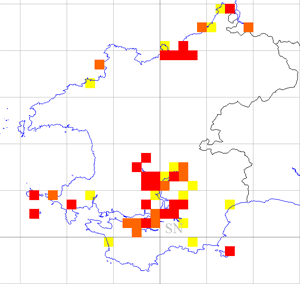Shelduck - 2013 - Cleddau Estuary WeBS counts
 Wednesday, January 1, 2014 at 12:04PM
Wednesday, January 1, 2014 at 12:04PM Shelduck in Pembrokeshire winter mainly on the Cleddau Estuary, with a few being recorded on the Teifi and Nevern Estuaries, and one or two occasionally on fresh-water sites.

In the 1980s birds would typically start arriving in November, with about a thousand present by January. These stayed until March, when numbers fell rapidly as birds moved back to their breeding grounds or moulting grounds. During the 1990s numbers built up steadily from October to a peak in January, then fell steadily. The peak counts were slightly lower than in the 1980s, and this was generally thought to be due to milder winters allowing birds to return earlier to more northerly areas. The GB national index remained reasonably steady during this time, suggesting that the population overall was not declining.
In the late 1990s the GB index fell slightly, but has now levelled out again. However, the numbers on the Cleddau have continued to decline and were below the level of national importance during the early 2000s. Numbers on the Burry Inlet also fell at this time. Outside of Wales, Poole Harbour, for example, has experienced a decline of about 60% in recent years (Musgrove, 2007). Not surprisingly the threshold has now been lowered, but the Cleddau system still only barely qualifies on a five-year average peak count.
The change in timing of birds arriving and departing the Cleddau may be linked to the recent run of mild winters, and to an increase in protected areas on the continental mainland.
Adult birds move from their wintering grounds to the breeding grounds and from there to moulting grounds in mid-late summer (Wernham, 2002). Young birds may move more slowly towards the moulting grounds. The locations used for moult may be changing, for example, most birds went to the Helgoland Bight in the German Waddensee, but in recent years the numbers of birds on British moulting grounds such as the Wash, Bridgewater Bay and the Dee/Mersey estuary have been increasing. The change in distances travelled may influence the timing of birds arriving back in their wintering grounds. There has been one ringing recovery showing movement of a bird between Pembrokeshire and the Waddensee, but are they still going there? These changes in moulting grounds may be linked to increasing numbers of shelduck breeding in Ireland.
There is no indication of any changes in food supply or other environmental factors on the estuary system that would explain observed trends.
Annie Haycock
Pembrokeshire WeBS coordinator






